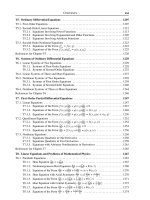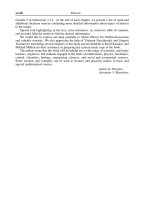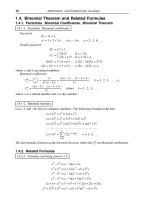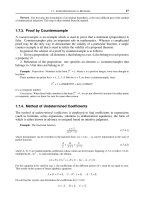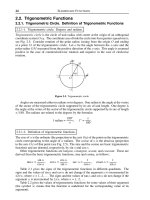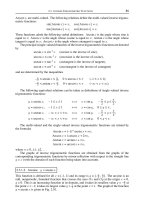Handbook of mathematics for engineers and scienteists part 48 ppsx
Bạn đang xem bản rút gọn của tài liệu. Xem và tải ngay bản đầy đủ của tài liệu tại đây (420.25 KB, 7 trang )
7.2. DEFINITE INTEGRAL 297
7. H
¨
older’s inequality (at p = 2, it translates into Bunyakovsky’s inequality):
b
a
f(x)g(x) dx
≤
b
a
|f(x)|
p
dx
1
p
b
a
|g(x)|
p
p–1
dx
p–1
p
, p > 1.
8. Chebyshev’s inequality:
b
a
f(x)h(x) dx
b
a
g(x)h(x) dx
≤
b
a
h(x) dx
b
a
f(x)g(x)h(x) dx
,
where f(x)andg(x) are monotonically increasing functions and h(x) is a positive integrable
function on [a, b].
9. Jensen’s inequality:
f
b
a
g(t)x(t) dt
b
a
g(t) dt
≤
b
a
g(t)f(x(t)) dt
b
a
g(t) dt
if f(x)isconvex(f
> 0);
f
b
a
g(t)x(t) dt
b
a
g(t) dt
≥
b
a
g(t)f(x(t)) dt
b
a
g(t) dt
if f(x) is concave (f
< 0),
where x(t) is a continuous function (a ≤ x ≤ b)andg(t) ≥ 0. The equality is attained if
and only if either x(t)=constorf(x) is a linear function. Jensen’s inequality serves as a
general source for deriving various integral inequalities.
10. Steklov’s inequality.Letf(x) be a continuous function on [0, π]andletithave
everywhere on [0, π], except maybe at finitely many points, a square integrable deriva-
tive f
(x). If either of the conditions
(a) f(0)=f(π)=0,
(b)
π
0
f(x) dx = 0
is satisfied, then the following inequality holds:
π
0
[f
(x)]
2
dx ≥
π
0
[f(x)]
2
dx.
The equality is only attained for functions f(x)=A sin x in case (a) and functions f(x)=
B cos x in case (b).
11. A π-related inequality.Ifa > 0 and f (x) ≥ 0 on [0, a], then
a
0
f(x) dx
4
≤ π
2
a
0
f
2
(x) dx
a
0
x
2
f
2
(x) dx
.
7.2.5-3. Arithmetic, geometric, harmonic, and quadratic means of functions.
Let f (x) be a positive function integrable on [a, b]. Consider the values of f(x)onadiscrete
set of points:
f
kn
= f (a + kδ
n
), δ
n
=
b – a
n
(k = 1, , n).
298 INTEGRALS
The arithmetic mean, geometric mean, harmonic mean, and quadratic mean of a function
f(x)onaninterval[a, b] are introduced using the definitions of the respective mean values
for finitely many numbers (see Subsection 1.6.1) and going to the limit as n →∞.
1. Arithmetic mean of a function f(x) on [a, b]:
lim
n→∞
1
n
n
k=1
f
kn
=
1
b – a
b
a
f(x) dx.
This definition is in agreement with another definition of the mean value of a function f(x)
on [a, b] given in Theorem 1 from Paragraph 7.2.5-1.
2. Geometric mean of a function f(x) on [a, b]:
lim
n→∞
n
k=1
f
kn
1/n
=exp
1
b – a
b
a
ln f (x) dx
.
3. Harmonic mean of a function f(x) on [a, b]:
lim
n→∞
n
n
k=1
1
f
kn
–1
=(b – a)
b
a
dx
f(x)
–1
.
4. Quadratic mean of a function f (x) on [a, b]:
lim
n→∞
1
n
n
k=1
f
2
kn
1/2
=
1
b – a
b
a
f
2
(x) dx
1/2
.
This definition differs from the common definition of the norm of a square integrable
function given in Paragraph 7.2.13-2 by the constant factor 1/
√
b – a.
The following inequalities hold:
(b –a)
b
a
dx
f(x)
–1
≤ exp
1
b – a
b
a
ln f(x) dx
≤
1
b – a
b
a
f(x) dx ≤
1
b – a
b
a
f
2
(x) dx
1/2
.
To make it easier to remember, let us rewrite these inequalities in words as
harmonic mean ≤ geometric mean ≤ arithmetic mean ≤ quadratic mean .
The equality is attained for f(x) = const only.
7.2.5-4. General approach to defining mean values.
Let g(y) be a continuous monotonic function defined in the range 0 ≤ y < ∞.
The mean of a function f(x) with respect to a function g(x) on an interval [a, b]is
defined as
lim
n→∞
g
–1
1
n
n
k=1
g(f
kn
)
= g
–1
1
b – a
b
a
g
f(x)
dx
,
where g
–1
(z)istheinverseofg(y).
The means presented in Paragraph 7.2.5-3 are special cases of the mean with respect to
a function:
arithmetic mean of f(x) = mean of f(x) with respect to g(y)=y,
geometric mean of f(x) = mean of f(x) with respect to g(y)=lny,
harmonic mean of f(x) = mean of f(x) with respect to g(y)=1/y,
quadratic mean of f (x) = mean of f(x) with respect to g(y)=y
2
.
7.2. DEFINITE INTEGRAL 299
7.2.6. Geometric and Physical Applications of the Definite Integral
7.2.6-1. Geometric applications of the definite integral.
1. The area of a domain D bounded by curves y = f(x)andy = g(x) and straight lines
x = a and x = b in the x, y plane(seeFig.7.2a) is calculated by the formula
S =
b
a
f(x)–g(x)
dx.
If g(x) ≡ 0, this formula gives the area of a curvilinear trapezoid bounded by the x-axis, the
curve y = f (x), and the straight lines x = a and x = b.
D
yfx= ()
()a ()b
ρφf= ()
α
β
ygx= ()
y
x
ab
O
Figure 7.2. (a) A domain D bounded by two curves y = f(x)andy = g(x)onaninterval[a, b]; (b) a curvilinear
sector.
2. Area of a domain D.Letx = x(t)andy =y(t), with t
1
≤ t ≤ t
2
, be parametric equations
of a piecewise-smooth simple closed curve bounding on its left (traced counterclockwise)
a domain D with area S.Then
S =–
t
2
t
1
y(t)x
(t) dt =
t
2
t
1
x(t)y
(t) dt =
1
2
t
2
t
1
x(t)y
(t)–y(t)x
(t)
dt.
3. Area of a curvilinear sector.Letacurveρ = f(ϕ), with ϕ
[α, β], be defined in the
polar coordinates ρ, ϕ. Then the area of the curvilinear sector {α ≤ ϕ ≤ β; 0 ≤ ρ ≤ f(ϕ)}
(see Fig. 7.2 b) is calculated by the formula
S =
1
2
β
α
[f(ϕ)]
2
dϕ.
4. Area of a surface of revolution. Let a surface of revolution be generated by rotating
acurvey = f(x) ≥ 0, x
[a, b], about the x-axis; see Fig. 7.3. The area of this surface is
calculated as
S = 2π
b
a
f(x)
1 +[f
(x)]
2
dx.
5. Volume of a body of revolution. Let a body of revolution be obtained by rotating
about the x-axis a curvilinear trapezoid bounded by a curve y = f(x), the x-axis, and straight
lines x = a and x = b; see Fig. 7.3. Then the volume of this body is calculated as
V = π
b
a
[f(x)]
2
dx.
300 INTEGRALS
yfx= ()
y
x
z
ab
O
Figure 7.3. A surface of revolution generated by rotating a curve y = f(x).
6. Arc length of a plane curve defined in different ways.
(a) If a curve is the graph of a continuously differentiable function y = f(x), x [a, b],
then its length is determined as
L =
b
a
1 +[f
(x)]
2
dx.
(b) If a plane curve is defined parametrically by equations x = x(t)andy = y(t), with
t
[α, β]andx(t)andy(t) being continuously differentiable functions, then its length is
calculated by
L =
β
α
[x
(t)]
2
+[y
(t)]
2
dt.
(c)Ifacurveisdefined in the polar coordinates ρ, ϕ by an equation ρ = ρ(ϕ), with
ϕ
[α, β], then its length is found as
L =
β
α
ρ
2
(ϕ)+[ρ
(ϕ)]
2
dϕ.
7. The arc length of a spatial curve defined parametrically by equations x = x(t),
y =y(t), and z = z(t), with t
[α, β]andx(t), y(t), and z(t) being continuously differentiable
functions, is calculated by
L =
β
α
[x
(t)]
2
+[y
(t)]
2
+[z
(t)]
2
dt.
7.2.6-2. Physical application of the integral.
1. Work of a variable force. Suppose a point mass moves along the x-axis from a point
x = a to a point x = b under the action of a variable force F(x) directed along the x-axis.
The mechanical work of this force is equal to
A =
b
a
F (x) dx.
7.2. DEFINITE INTEGRAL 301
2. Mass of a rectilinear rod of variable density. Suppose a rod with a constant cross-
sectional area S occupies an interval [0, l]onthex-axis and the density of the rod material
is a function of x: ρ = ρ(x). The mass of this rod is calculated as
m = S
l
0
ρ(x) dx.
3. Mass of a curvilinear rod of variable density. Let the shape of a plane curvilinear rod
with a constant cross-sectional area S be defined by an equation y = f(x), with a ≤ x ≤ b,
and let the density of the material be coordinate dependent: ρ = ρ(x, y). The mass of this
rod is calculated as
m = S
b
a
ρ
x, f(x)
1 +[y
(x)]
2
dx.
If the shape of the rod is defined parametrically by x = x(t)andy = y(t), then its mass
is found as
m = S
b
a
ρ
x(t), y(t)
[x
(t)]
2
+[y
(t)]
2
dt.
4. The coordinates of the center of mass of a plane homogeneous material curve whose
shape is definedbyanequationy = f(x), with a ≤ x ≤ b, are calculated by the formulas
x
c
=
1
L
b
a
x
1 +[y
(x)]
2
dx, y
c
=
1
L
b
a
f(x)
1 +[y
(x)]
2
dx,
where L is the length of the curve.
If the shape of a plane homogeneous material curve is defined parametrically by x = x(t)
and y = y(t), then the coordinates of its center of mass are obtained as
x
c
=
1
L
b
a
x(t)
[x
(t)]
2
+[y
(t)]
2
dt, y
c
=
1
L
b
a
y(t)
[x
(t)]
2
+[y
(t)]
2
dt.
7.2.7. Improper Integrals with Infinite Integration Limit
An improper integral is an integral with an infinite limit (limits) of integration or an integral
of an unbounded function.
7.2.7-1. Integrals with infinite limits.
1
◦
.Lety = f(x)beafunctiondefined and continuous on an infinite interval a ≤ x < ∞.If
there exists a finite limit lim
b→∞
b
a
f(x) dx, then it is called a (convergent) improper integral
of f (x) on the interval [a, ∞) and is denoted
∞
a
f(x) dx. Thus, by definition
∞
a
f(x) dx = lim
b→∞
b
a
f(x) dx.(7.2.7.1)
If the limit is infinite or does not exist, the improper integral is called divergent.
The geometric meaning of an improper integral is that the integral
∞
a
f(x) dx, with
f(x) ≥ 0, is equal to the area of the unbounded domain between the curve y = f (x), its
asymptote y = 0, and the straight line x = a on the left.
302 INTEGRALS
2
◦
. Suppose an antiderivative F(x) of the integrand function f (x) is known. Then the
improper integral (7.2.7.1) is
(i) convergent if there exists a finite limit lim
x→∞
F (x)=F (∞);
(ii) divergent if the limit is infinite or does not exist.
In case (i), we have
∞
a
f(x) dx = F (x)
∞
a
= F (∞)–F (a).
Example 1. Let us investigate the issue of convergence of the improper integral I =
∞
a
dx
x
λ
, a > 0.
The integrand f(x)=x
–λ
has an antiderivative F (x)=
1
1 – λ
x
1–λ
. Depending on the value of the parameter
λ,wehave
lim
x→∞
F (x)=
1
1 – λ
lim
x→∞
x
1–λ
=
0 if λ > 1,
∞ if λ ≤ 1.
Therefore, if λ > 1, the integral is convergent and is equal to I = F (∞)–F (a)=
a
1–λ
λ – 1
,andifλ ≤ 1,the
integral is divergent.
3
◦
. Improper integrals for other infinite intervals are defined in a similar way:
b
–∞
f(x) dx = lim
a→–∞
b
a
f(x) dx,
∞
–∞
f(x) dx =
c
–∞
f(x) dx +
∞
c
f(x) dx.
Note that if either improper integral on the right-hand side of the latter relation is convergent,
then, by definition, the integral on the left-hand side is also convergent.
4
◦
. Properties 2–4 and 6–9 from Paragraph 7.2.2-2, where a can be equal to –∞ and b can
be ∞, apply to improper integrals as well; it is assumed that all quantities on the right-hand
sides exist (the integrals are convergent).
7.2.7-2. Sufficient conditions for convergence of improper integrals.
In many problems, it suffices to establish whether a given improper integral is convergent
or not and, if yes, evaluate it. The theorems presented below can be useful in doing so.
T
HEOREM 1(CAUCHY’S CONVERGENCE CRITERION).
For the integral (7.2.7.1) to be
convergent it is necessary and sufficient that for any
ε > 0
there exists a number
R
such that
the inequality
β
α
f(x) dx
< ε
holds for any
β > α > R
.
THEOREM 2.
If
0 ≤ f (x) ≤ g(x)
for
x ≥ a
, then the convergence of the integral
∞
a
g(x) dx
implies the convergence of the integral
∞
a
f(x) dx
; moreover,
∞
a
f(x) dx ≤
∞
a
g(x) dx
. If the integral
∞
a
f(x) dx
is divergent, then the integral
∞
a
g(x) dx
is also
divergent.
7.2. DEFINITE INTEGRAL 303
T
HEOREM 3.
If the integral
∞
a
|f(x)|dx
is convergent, then the integral
∞
a
f(x) dx
is also convergent; in this case, the latter integral is called absolutely convergent.
Example 2. The improper integral
∞
1
sin x
x
2
dx is absolutely convergent, since
sin x
x
2
≤
1
x
2
and the
integral
∞
1
1
x
2
dx is convergent (see Example 1).
THEOREM 4.
Let
f(x)
and
g(x)
be integrable functions on any finite interval
a ≤ x ≤ b
and let there exist a limit, finite or infinite,
lim
x→∞
f(x)
g(x)
= K.
Then the following assertions hold:
1. If
0 < K < ∞
, both integrals
∞
a
f(x) dx,
∞
a
g(x) dx (
7
.2.7.2)
are convergent or divergent simultaneously.
2. If
0 ≤ K < ∞
, the convergence of the latter integral in (7.2.7.2) implies the conver-
gence of the former integral.
3. If
0 < K ≤ ∞
, the divergence of the latter integral in (7.2.7.2) implies the divergence
of the former integral.
THEOREM 5(COROLLARY OF THEOREM 4).
Given a function
f(x)
, let its asymptotics
for sufficiently large
x
have the form
f(x)=
ϕ(x)
x
λ
(λ > 0).
Then: (i) if
λ > 1
and
ϕ(x) ≤ c < ∞
, then the integral
∞
a
f(x) dx
is convergent; (ii) if
λ ≤ 1
and
ϕ(x) ≥ c > 0
, then the integral is divergent.
THEOREM 6.
Let
f(x)
be an absolutely integrable function on an interval
[a, ∞)
and let
g(x)
be a bounded function on
[a, ∞)
. Then the product
f(x)g(x)
is an absolutely integrable
function on
[a, ∞)
.
THEOREM 7(ANALOGUE OF ABEL’S TEST FOR CONVERGENCE OF INFINITE SERIES).
Let
f(x)
be an integrable function on an interval
[a, ∞)
such that the integral (7.2.7.1) is
convergent (maybe not absolutely) and let
g(x)
be a monotonic and bounded function on
[a, ∞)
. Then the integral
∞
a
f(x)g(x) dx (
7
.2.7.3)
is convergent.
THEOREM 8(ANALOGUE OF DIRICHLET’S TEST FOR CONVERGENCE OF INFINITE SE-
RIES).
Let (i)
f(x)
be an integrable function on any finite interval
[a, A]
and
A
a
f(x) dx
≤ K < ∞ (a ≤ A < ∞);
(ii)
g(x)
be a function tending to zero monotonically as
x →∞
:
lim
x→∞
g(x)=0
. Then the
integral (7.2.7.3) is convergent.



